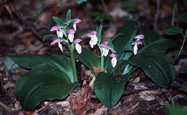Galearis spectabilis (L.) Raf.
Showy orchis
The generic name Galearis is derived from the Greek galea
which means "helmet" and refers to the helmet-like appearance
of the connivent sepals and petals. The genus contains 11 species in a classic
Arcto-Tertiary disjunct pattern: 10 are found in East Asia, with Galearis
spectabilis found in the southeastern United States. The specific epithet
spectabilis is the Latin meaning "showy" or "remarkable,"
in reference to the beautiful flowers.


DESCRIPTION: Plant arising
from a cluster of fleshy, thickened roots, 8-20 cm high (including inflorescence).
Leaves 2 (sterile plants usually have only one leaf), basal, obovate
to elliptical, 8-18 cm long and 2-8 cm wide. Inflorescence a loose
or dense raceme, 2-10 flowered; flowers subtended by conspicuous lanceolate,
acuminate bracts, 1.5-4 cm long, the lower bracts longer and typically greatly
exceeding the length of the ovary and pedicel. Sepals elliptic to
ovate-lanceolate, 1-2 cm long and 5-6 mm wide, purple (rarely white); sepals
connivent with petals to form a hood over the column, opposite the labellum.
Petals lance-linear, 1-2 cm long and 2-5 mm wide, closely appressed
to the sepals and colored as the sepals. Labellum ovate, the margins
typically wavy, white (or rarely purple), 1-2 cm long and 7-12 mm wide;
labellum with a 10-18 mm clubbed nectar spur projecting behind from
the base.
SIMILAR SPECIES: It is unlikely that Galearis could be confused
with any other plant in the Wisconsin flora.
HABITAT: Typically found in moist, rich deciduous forests. Galearis
is almost always found in areas of light disturbance. I have frequently
found it along trails, on flood terraces of small streams, or on steep slopes.
All of these microsites are subject to intermittent disturbance; apparently
this minimal disturbance is necessary to create the proper habitat for the
establishment of Galearis. Studies in the Great Smoky Mountains have
shown that Galearis is particularly prevalent along trails (Bratton
????)
FLOWERING DATES: May 10-June 10.
POLLINATION: Galearis flowers in early spring, when one of the most
common pollinators is the bumblebee. Bumblebees visit the flowers for the
nectar reward stored in the spur, and during their visit the pollinia become
attached to the frons of the bee (Robertson
1928, Dieringer 1982).
WI DISTRIBUTION:  U.S. DISTRIBUTION:
U.S. DISTRIBUTION:
Go directly to Wisconsin herbarium records.
Return
to the main LIST of the Orchids of Wisconsin.
Return to the main KEY to the Orchids of
Wisconsin.


 U.S. DISTRIBUTION:
U.S. DISTRIBUTION: